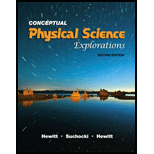
According to nebular theory, did the planets start before or after Sun ignited?
Whether the planets starts forming before or after the ignition of Sun.
Answer to Problem 5RQ
The planets starts forming before the Sun ignited because the formation of Sun occurred due to the high temperature of the central portion and it happened after more time.
Explanation of Solution
The formation of planets occurs due to the rotation of nebula. The nebula changes its disk shape from spherical shape due to faster rotation. The central portion of the nebula becomes hot and nuclear fission ignited.
The central portion of the nebula changes to Sun and planets are formed by the surrounding material of the nebula around the Sun. The nebula begins hot due to the radiated energy of the Sun.
The more dense surrounding material in the vicinity of the Sun forms the inner planets and less dense material away from the Sun forms the outer planets. The formation of the planets starts before the ignition of the Sun.
Conclusion:
Therefore, the planets starts forming before the Sun ignited because the formation of Sun occurred due to the high temperature of the central portion and it happened after more time.
Chapter 32 Solutions
Conceptual Physical Science Explorations
Additional Science Textbook Solutions
Cosmic Perspective Fundamentals
University Physics Volume 2
The Cosmic Perspective
College Physics (10th Edition)
Conceptual Integrated Science
University Physics with Modern Physics (14th Edition)
 College PhysicsPhysicsISBN:9781305952300Author:Raymond A. Serway, Chris VuillePublisher:Cengage Learning
College PhysicsPhysicsISBN:9781305952300Author:Raymond A. Serway, Chris VuillePublisher:Cengage Learning University Physics (14th Edition)PhysicsISBN:9780133969290Author:Hugh D. Young, Roger A. FreedmanPublisher:PEARSON
University Physics (14th Edition)PhysicsISBN:9780133969290Author:Hugh D. Young, Roger A. FreedmanPublisher:PEARSON Introduction To Quantum MechanicsPhysicsISBN:9781107189638Author:Griffiths, David J., Schroeter, Darrell F.Publisher:Cambridge University Press
Introduction To Quantum MechanicsPhysicsISBN:9781107189638Author:Griffiths, David J., Schroeter, Darrell F.Publisher:Cambridge University Press Physics for Scientists and EngineersPhysicsISBN:9781337553278Author:Raymond A. Serway, John W. JewettPublisher:Cengage Learning
Physics for Scientists and EngineersPhysicsISBN:9781337553278Author:Raymond A. Serway, John W. JewettPublisher:Cengage Learning Lecture- Tutorials for Introductory AstronomyPhysicsISBN:9780321820464Author:Edward E. Prather, Tim P. Slater, Jeff P. Adams, Gina BrissendenPublisher:Addison-Wesley
Lecture- Tutorials for Introductory AstronomyPhysicsISBN:9780321820464Author:Edward E. Prather, Tim P. Slater, Jeff P. Adams, Gina BrissendenPublisher:Addison-Wesley College Physics: A Strategic Approach (4th Editio...PhysicsISBN:9780134609034Author:Randall D. Knight (Professor Emeritus), Brian Jones, Stuart FieldPublisher:PEARSON
College Physics: A Strategic Approach (4th Editio...PhysicsISBN:9780134609034Author:Randall D. Knight (Professor Emeritus), Brian Jones, Stuart FieldPublisher:PEARSON





